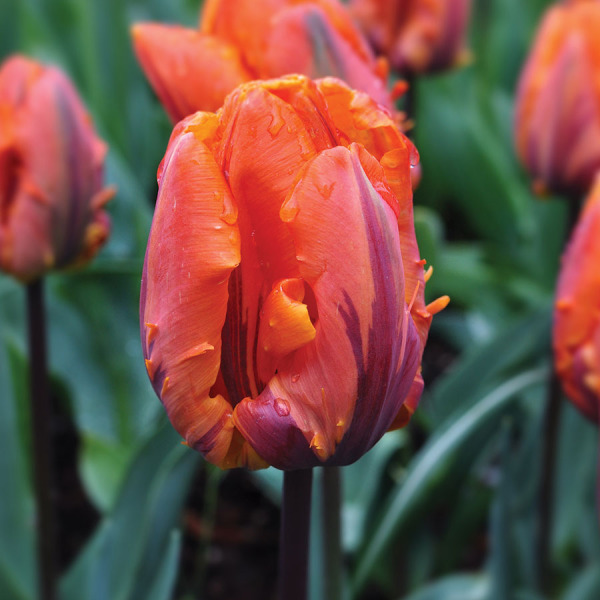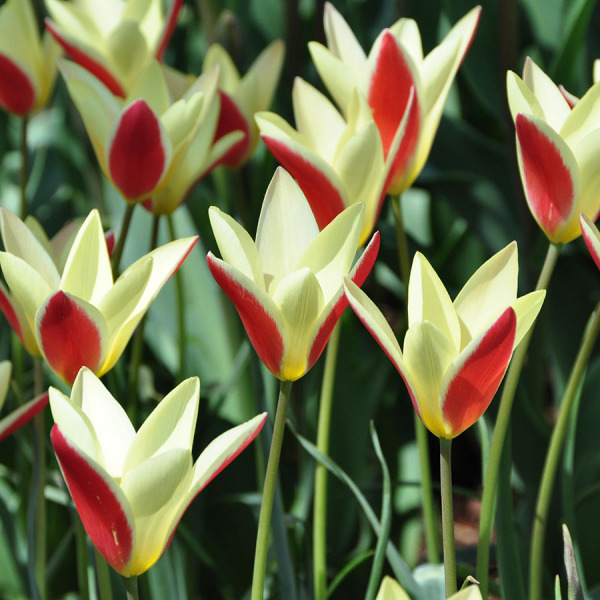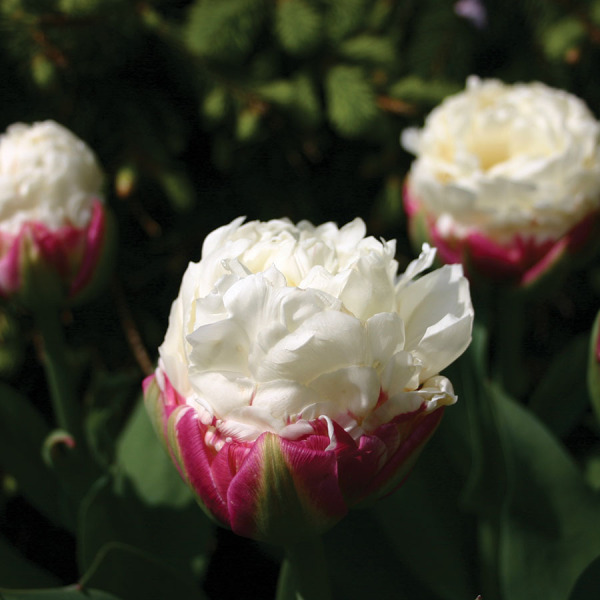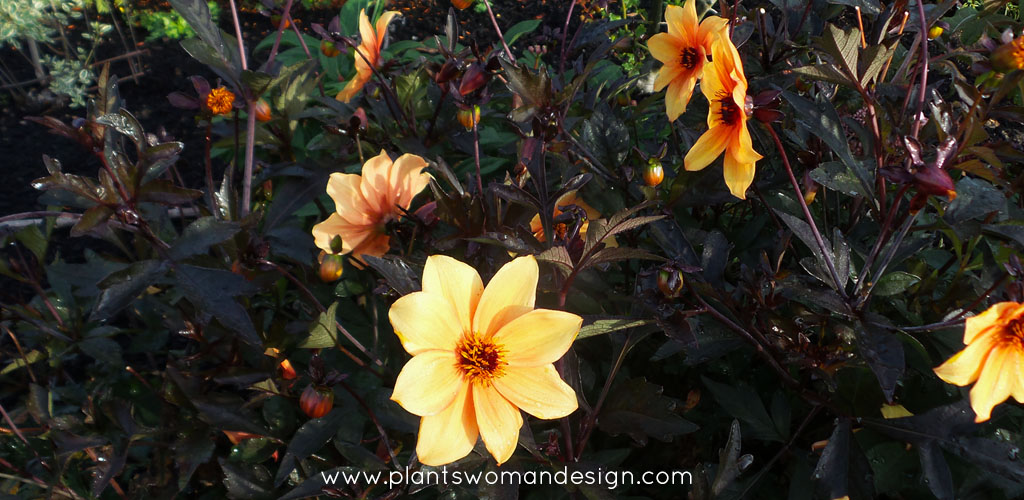
by Susan | Sep 11, 2015 | gardening, plants
Yes, even pumpkins can be beautiful. I love orange in the garden and even when I’m growing pumpkins I enjoy the color. This fabulous thing is a Warty Thing Pumpkin (Cucurbita maxima). Yes these are giant and lovely, a great eating squash and good for pies. Could make a super scary jack o lantern!! Grab seeds next year from (link) Botanical Interests Seeds.
Lush Begonia Non-stops are a must have every year. I just can’t leave them alone at the nursery and add to my collection each year. Try the Non-Stop apricot for amazing combinations of orange, yellow and peach. Take a look on the Little Bytes page for more information on over wintering the tubers each year.
Anything tropical that will prove hardy always has a place in my garden. The hardy hedychium densiflorum is easy to grow and is a spectacular accent. This one has moved with me several times and more is always available at (Link) Far Reaches Farms.
Just last night I hear Helen Dillon (Irish garden fame) mention this plant in her garden. This is a canna musaefolia (syn canna musifolia) or Banana Canna. Named for its banana like foliage it is lush, tropical and perfectly hardy at zone 7.
Crocosmia Venus tagged along with an Agapanthus that I brought from my old garden. It pushes its way into the mix and has to compete with some shade but is a bright spot against the red banana leaves in the background. Nils Sundquist from Sundquist nursery grows this and many other lovely crocosmias.
The bright sunny Echinacea ‘Sombrero Adobe Orange’ is new to me this year. I love the fact it has various shades of orange/pink/peach on the same plant. The flowers change as they age. Recommended to my by one of the growers at TandL Nursery I agree with their pick. It has a strong growing habit and seems to be a prolific bloomer.
Graceful with recurving petals the Lily (Lilium Rosthornii) from Far Reaches Farms is also new to my garden this year. I have several others including a double Tiger Lily (Lilium flore-pleno). Unbelievably brilliant!
How about a little Orange Garden Art? Tucking in the orange birdbath on a rusty stand with a Chocolate Silk Mimosa Tree (albizia julibrissin “Summer Chocolate’) adds a punch of color and contrasting textures.
Speaking of garden art. I repeat the theme here with orange glass and Canna Intrique. It also blooms orange –here is a picture of the orange flower! Zow. ( Insert picture of flower here. )
More Begonias and more begonias, I told you I couldn’t help myself. The Begonia ‘Sparks will fly’ has very cool dark foliage, while the bright green foliage of Begonia Boliviensis ‘Bonfire Orange’ has a fernlike texture mixed with other ferny things under the apple tree. Bright orange in the shade is a must.
This Dahlia has a funny story behind it. I was shopping for a customer’s bright orange in a blue/orange bed. The recommendation from the grower was Dahlia ‘mystic spirit’. Well it came in and was not a great clear orange but a peachy/pink. It would not go with the other hot colors in the bed. So as often happens I just dumped the dahlias in an empty spot in my garden. Not exactly overjoyed with them but not willing for them to die either. NOW they are really coming into a good sturdy bloom and the flowers are a great soft orange. Not at all like the blooms that were first on them, hard to figure out, maybe a fertilizing thing (they get none now). BUT I’m liking them and they may get to stay after all. Love the dark foliage on them.
I hope you have enjoyed this visit through the orange in my garden. I will admit this isn’t it. There are a few more orange flowers that I may share with you another time.

by Susan | Aug 14, 2015 | gardening
Why blog about water. Why not? It is a precious resource that is in short supply this year. Just ask the trees and plants in our landscapes and gardens. For some reason the recent calls of ‘drought, drought, drought’ have given people an excuse to kill their plants. These are lovely plants that have been getting by for years with little or no water other than that which falls from the sky. This year our sky has dried up. The plants are still expecting a daily drink so they can continue to live. BUT well meaning people hear the word drought and, instead of making sure the very things that need it most get enough water to survive, don’t even give them a drop. Mind you in my area we do not have water restrictions, notices about lawn water or car washing. No public outcry against mindless useless waste of water. This is the first week that the City of Seattle has asked homeowners to reduce the consumption of water by 10 % as a precautionary measure.
Here is a picture of a lovely dogwood growing next to the church. It is at least 20 years old and it is dying. No water. Leaves are curling and dropping. It really doesn’t need much just about an inch a week around its drip line. The historical significance of this tree should demand its upkeep. We have many historical trees on Bainbridge Island and many are protected from development. However they too are stressed and may be dying from lack of water.
This row of rhododendrons has been planted for several years. They give off oxygen that helps the environment, they have a screening value for the house and there has been money spent on them. To replace them at this more mature size will impact the wallet more significantly than before and help to fill up the landfill. Giving these plants a small drink of water once a week will prevent the waste of these resources.
Don’t even get me started on the parking lots were the sprinklers haven’t been turned on at all and mature trees and shrubs are all dead. New commercial construction projects with re-forestation of disturbed land are also dead. Temporary irrigation heads and hose run by all the native plants but no water is on. You can drive down the road and see mature firs and maples struggling to survive. We can’t do much about the verges of the highway but we can help plants around us live.
Here are a few signs that the plants in your garden or area that you live in are in need of water.
- Premature leaf drop. No Fall is not here early simply because the leaves are falling off, it is stress. Water it.
- Evergreens wilting. Rhododendrons, pines, pieris and other evergreens should have leaves at a natural angle. If they are downturned they need water. Water it.
- Brown tips of plants. Not enough water to get to the end of the branches. The tips die first and the plant shrinks its resources to the middle of the plant to help it survive. Water it.
- Lots of cones or seed pods. This means that the tree could be stressed to the point of death. The method of preservation of the species for plants is that if they are stressed they will send out more seeds so the seeds can grow into new plants after the larger tree is dead. WATER IT!
- Other plants close by are dead. This likely means that the shrub or evergreen may look ok (not great) but will not make it through the winter because the roots are unable to be full and plump with water. Fine hair roots will dry up and go away without water and even when water comes they will have to re-grow to recover. WATER IT!!!
Okay, rant over. Let’s talk about how to water wisely so we are not wasting this precious resource.
- Water around the root base thoroughly at least one time a week on mature established plants. New plants (less than 2 years old) need water at least 3 times a week. You can use a soaker hose with mulch over it (mulch helps hold the water against evaporation), BUT make sure it is on long enough. The soaker hose has to be close to the plant, the water does not travel like on a sprinkler so if it is more than 1 inch away the plant will not benefit. If it is only on 1 side then only one side of the plant will have roots.
I visited a garden last week where the soaker hose ran down the center of the bed with plants at least 1 foot away and they were all dead. That was a waste of water.
- Mulch with organic mulch to help retain moisture.
- Put a small can or bowl out in your garden to measure water, 1 Inch per week during this hot dry summer. A cloudy day does not produce water from the sky, just clouds. Yes, it helps relieve the plant from relentless sun but water is still needed.
- Use your irrigation system for less time and less often. Change the times and amount of flow to get to the 1 inch mark. If some plants struggle individually give them a little more. They will eventually become less water greedy if weaned off the water slowly.
As I was driving home today I drove by a car lot with a lot attendant hose in hand spraying a rhododendron shrub at the edge of a bed. It was completely brown, leaves folded in death, obviously beyond the help of water. Don’t waste water on plants that look like that. We still have most of August left, all of September and October to go. Often times the warm weather continues until October and sometimes the dryness continues as well. October 2014 broke all records for being the warmest and wettest on record.
OH…. Let’s talk about that. Yes the snow pack is down but last year was the 5th wettest year on record with a crazy 48.50 inches of rain, 11 inches above normal! Seattle Public utilities held more water in the reservoirs than normal because of the lack of snow pack. I think there is still water in the hills, reservoirs are still holding water and there is still enough water for the plants and us. Let’s Use it wisely.
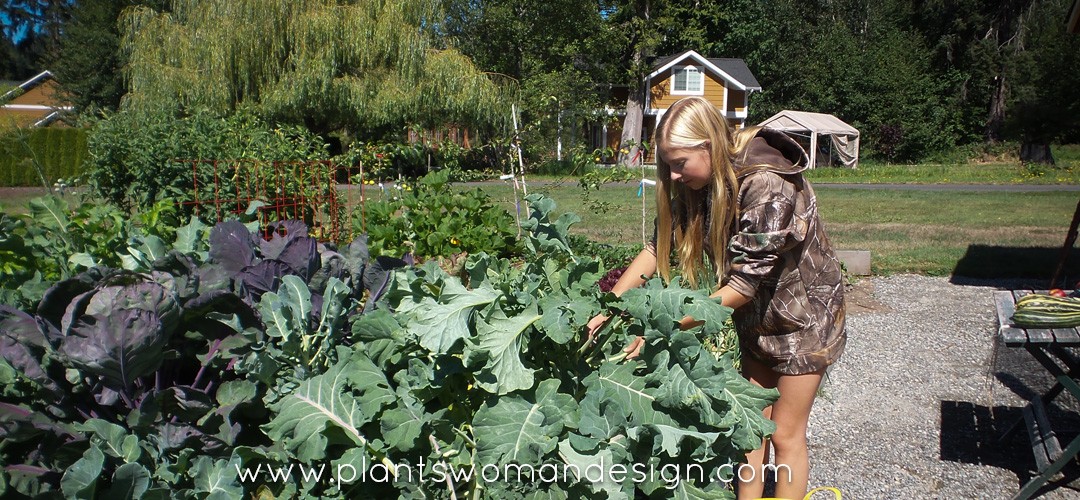
by Susan | Jul 31, 2015 | gardening
There is something about the fragrance, color and lushness of the garden that is unbelievable at this time of year. Harvesting vegetables from the garden and feeling the warmth of the soil has always been one of my simple joys. The summer night is still and the moon is huge and bright. Fragrant Nicotiana and jasmine scent sighs in through the bedroom window bringing with it a calm soothing sleep.
Here are my 5 favorite ways to celebrate Summer’s Bounty
1. Pick vegetables or fruit and make something to share. From your own garden or at a roadside u-pick garden it is a great activity for you alone or to share with kids. If you don’t have a kid available you can always borrow a neighbor’s. I know several who are available to help with harvesting, cooking and eating. Touching the earth, feeling its warmth and smelling the soil brings us a connection with our dependence on the earth. The food bank in your area is happy to have any excess food you may harvest or swapping with a neighbor for what they might have is another way to share.
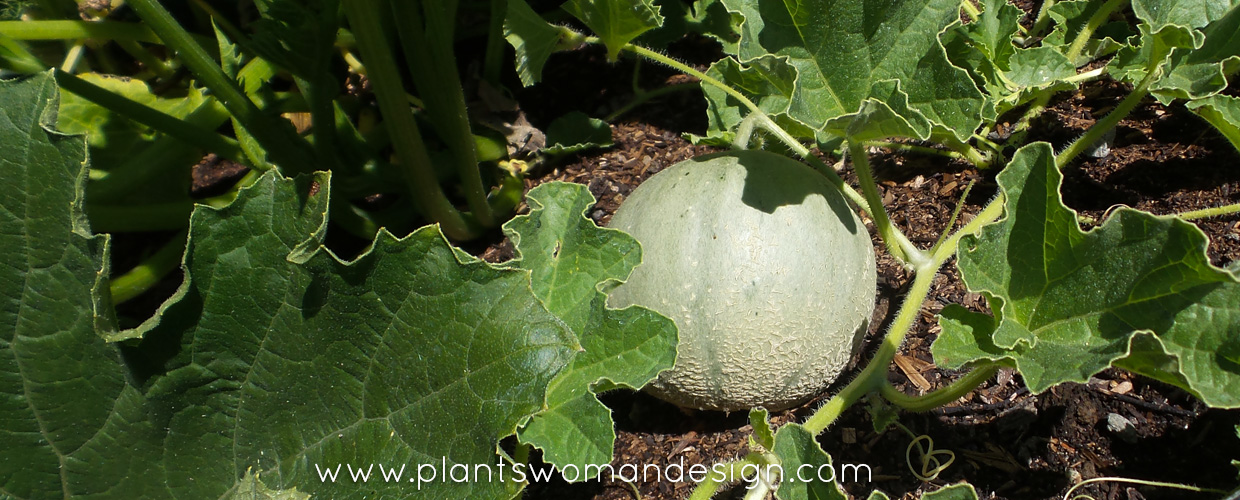
2. Visit a Farmers market and share. It’s wonderful to visit with vendors, get good information on what varieties they grow so you can grow them next year. Seed packets are great but sometimes tasting a veg or fruit gives real taste to choices. There are wonderful sweet cantaloupes that grow in the San Juan Islands. I grew a variety from the seed rack this year but next year I will try to find out what variety they grow. Theirs must mature quicker because we were eating them in July and mine are still green.
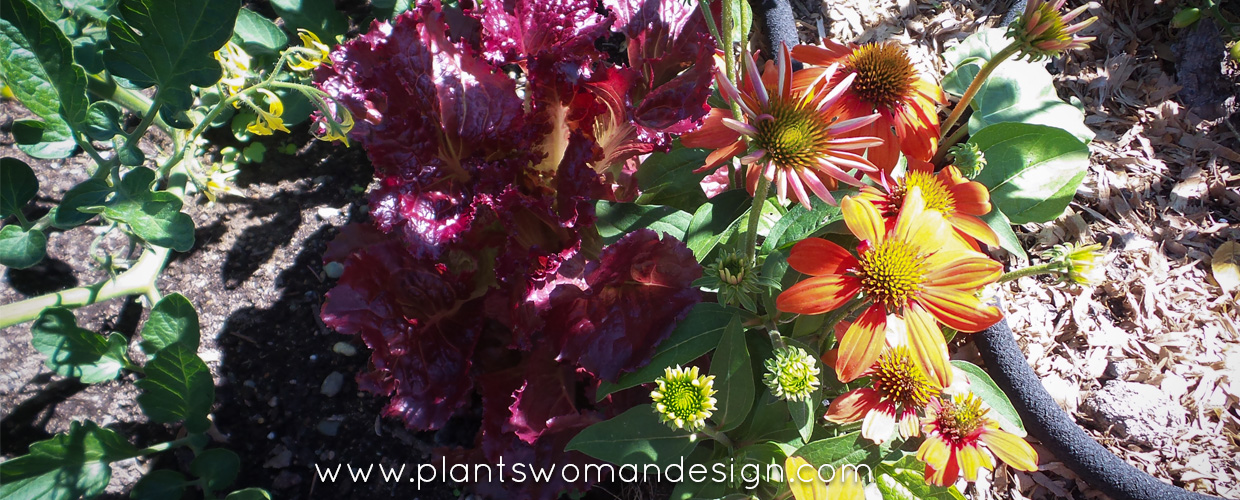
3. Pick a bouquet of flowers from your garden and share them with a friend. Maybe with a person that lives in a condo or an elderly person who can no longer get out. Maybe with a friend who just needs to know you care. If you don’t have a lot of flowers in your garden do an arrangement of leaves and twigs. I’ve also been known to engage in ‘civic pruning’ i.e. collecting branches and flowers from roadside ditches or abandoned properties. There are endless combinations to try. You can always pick some up at the farmers market or a roadside stand too. The point is to enjoy the beauty, grow them or shop locally, and share what inspires you with others.
4. Go out into a local garden or footpath. Just getting out among the trees and growing things is exactly what will encourage you and inspire new ideas in your mind. We have lovely Bloedel Reserve here in the Pacific Northwest. It’s a stunning place to stroll, contemplate and rejuvenate. Supporting local gardens with your patronage is as important as supporting them financially or in volunteer work.
Blodel Reserve offers a ‘Strolls for Well-being’ program where participants take part in planned walks and meditations with themes focusing on awareness, forgiveness, and gratitude to help people cope with life’s twists and turns. Garden as therapy!
Go out on a hike with The Nature Conservancy.
5. Sit outside in the evening. Watch the moon rise, listen to the earth falling still and quiet. See night flying insects, (wear mosquito spray – Burts bees’ makes a great one), look for bats and see the stars come out. I grow several types of flowers that only smell at night. Enjoying their fragrance and seeing the beauty of their white flowers is also a way to enjoy the bounty of nature. A few weeks ago I met a Hummingbird Moth, check out the video below.
How do you enjoy the summer bounty in your area?
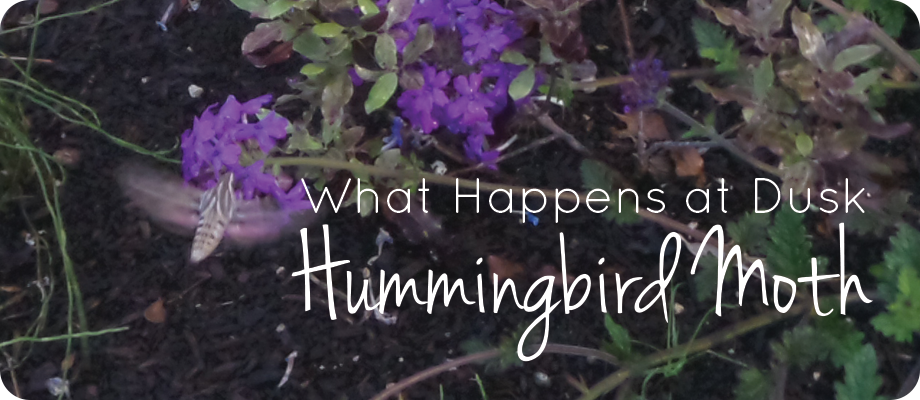
by Susan | Jun 2, 2015 | gardening
Sometimes it is hard to quit gardening. I putter, water, weed, deadhead, look, pick, and plant well into the evening hours. I guess it is an obsession (Duh right?). A warm Sunday evening found me putting away the remainder of my tools, wrapping up hoses, and cleaning up. While doing this I was buzzed by a large insect. Why would a humming bird be out this late? What else could it be? I stood still and waited for a return visit. Again a buzz, and flutter of wings past me, and again I thought humming bird. Soon another joined the first and then a third. Standing very still I started to observe what was going on. I ran in to get my camera and quietly came back. Unbelievable. A black and white insect with wings that beat so fast you could not see them. It has a long proboscis and was darting from flower to flower pollinating.
After the video session, where the star of the show continued to fly around, a visit to Google was in store. I looked up hummingbird and moth together. I found several types of Hummingbird Moths and identified mine. It is a Hyles Lineata or White Sphinx Moth. The common name comes from the way they fly, with wings moving in a blur, and hovering for nectar like a humming bird. This one was so cool. The zebra like striping and the red/pink wing edges were beautiful.
In all the years I have lived here and gardened I had never spotted one before. I don’t know if they are new to my area or because of the location of the property I’m the new one to the area.
Here are some more facts about these fascinating creatures…
- They are not considered a pest and usually inhabit desert areas, or warm areas. It was a warm night and when I looked for them on subsequent nights when it was cooler I didn’t see them. Some information suggests that when they colonize an area they will move further north to colonize another area. Possibly the explanation of why I’ve never seen them before.
- Adults fly at dusk, during the night and at dawn.
- Caterpillars pupate in shallow burrows in the ground. A
- dults eat nectar form columbines, larkspurs, petunia, honeysuckle, moonvine, bouncing bet, lilac, clovers, thistles, and Jimson Weed. Mine were on Verbena ‘Homestead Purple’. They like tubular flowers like the Hummingbird.
Enjoy this video and be on the lookout! You may have them in your garden too. Let me know if you see them.
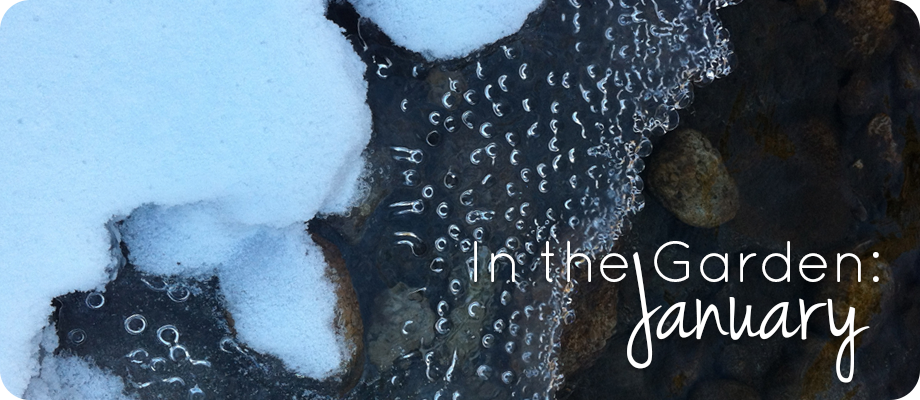
by Susan | Jan 30, 2015 | gardening
It is fun to sit and contemplate the planning of a garden for the coming year. Many times we are anxious to get out and get going,which is great because there are a few things that need to be done while plants are still dormant. Here is the short list of things to be done in the garden right now. Of course I live in the PNW where the ground is not covered with snow but many of these things can be done weather permitting. They should be done before ‘bud break’ (when color shows on buds).
Here’s what you can be doing in the garden right now…
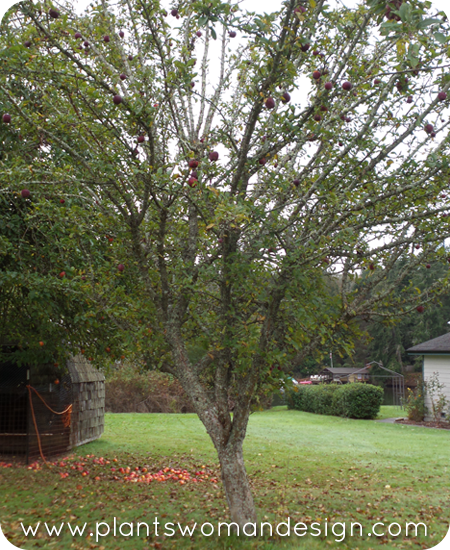 PRUNING FRUIT TREES
PRUNING FRUIT TREES
Now is a great time to check out the structure and get rid of waterspouts and crossing branches. I prune all fruit trees now with the exception of cherry and apricot trees (prunus species). These trees are usually pruned in the summer after fruiting because they are more susceptible to cankers and infection in the winter. Great advice on pruning fruit trees is available from RHS Gardening book “Pruning and Training”. In fact this book is great for pruning almost every shrub I have ever encountered. Take a look at our Fear of Gardening post for more information on pruning.
SPRAYING FRUIT TREES
This is also the time to spray horticultural oil on fruit trees. In Washington state we have a problem with apple codling moth. This pest is prevalent throughout the state because of the massive amounts of old abandoned apple trees and lack of control. Even if you don’t eat your apples you can still help with the control of these unwanted pests. Neem Oil is a naturally occurring pesticide that can help with control. This non-toxic oil helps to kill insects that are overwintering on fruit trees. Other things can be used at different times in the year but now is the time to spray with Neem Oil.
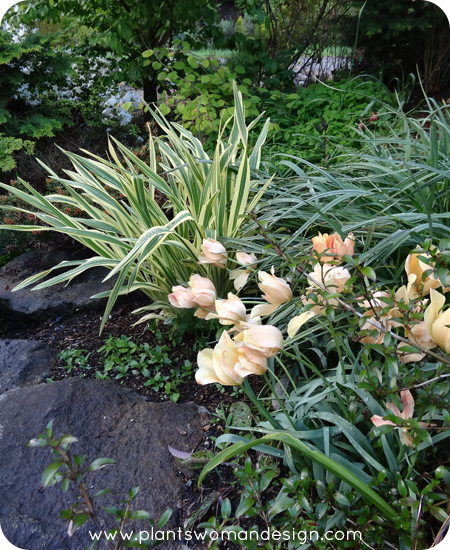 GARDEN TIDY
GARDEN TIDY
Cutting back grasses and cleaning up grounds is a good task for this month. Clean up and mulching now will help with weed control later in the year. I leave a pile of the dried grasses out of the compost heap for birds to use for fodder and nesting.
I also cut back the leaves from my hellebores and my epimediums right now. The sight of the blooms without the messy leaves has more drama than the blooms through the winter damaged leaves.
Check for insect or pest damage. I noticed that my crocus were being eaten. It is too early for slugs and snails so I suspect the rabbits that my neighbor ‘loves’ are to blame. I placed an inverted plant tray over the top of them so they have protection from munching. I will eventually have to add another couple to the stack so that as the leaves and blossoms come out they still have protection.
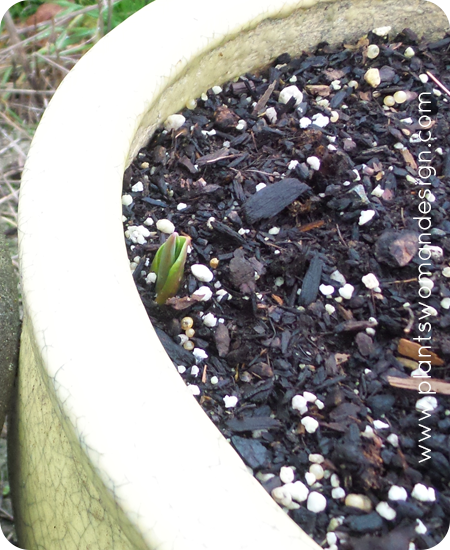 FORCED WINTER BULBS
FORCED WINTER BULBS
I have several pots that I put bulbs in last fall that have been sitting outside ‘chilling’. Now is the time to bring those into a warmer place if you want them to bloom early. You can bring them into the greenhouse or sunny room. The warmth and the light will give them the illusion of spring and bring them up early.
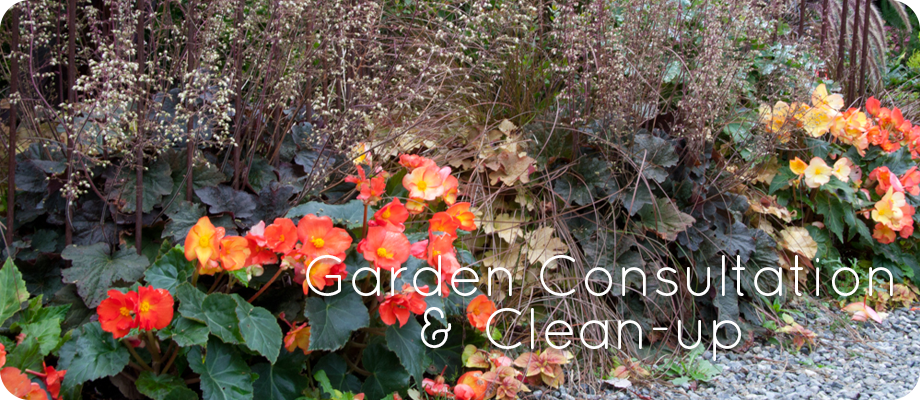 Need help? Right now you can get $25 off a garden consultation or clean up service with Plantswoman Design when you mention this post. We know some of our blog followers aren’t in our neighborhood but that’s okay! We can meet over the phone and I can answer your questions, help you make a plan for spring and if necessary we can set up a video call. Email us at info[at]plantswomandesign[dot]com or call us at 206-842-2453.
Need help? Right now you can get $25 off a garden consultation or clean up service with Plantswoman Design when you mention this post. We know some of our blog followers aren’t in our neighborhood but that’s okay! We can meet over the phone and I can answer your questions, help you make a plan for spring and if necessary we can set up a video call. Email us at info[at]plantswomandesign[dot]com or call us at 206-842-2453.
Information in this post originally appeared in the Plantswoman Design monthly newsletter. Want these great tips and information delivered to you monthly? Just put your email below and you will be added to the list! (please note this list is different from subscribing to the blog)
[mc4wp_form]
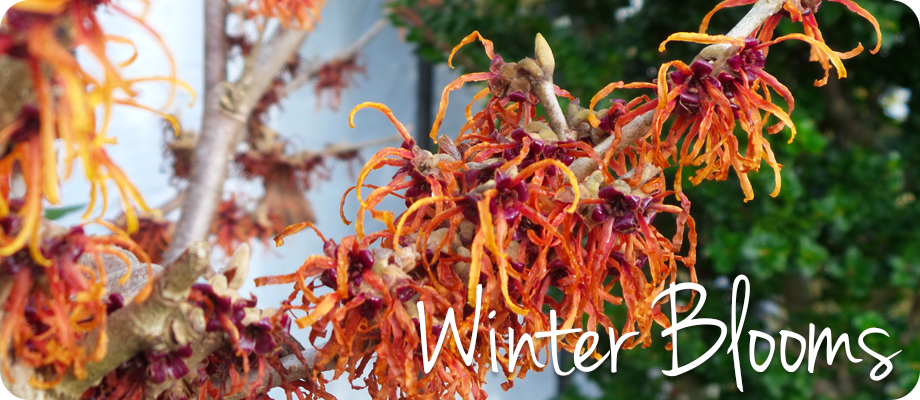
by Susan | Jan 23, 2015 | gardening, plants
It is cold and clear this morning. As you can see I was out in the beautiful morning. Even as cold as it is there are things to see in the garden. These tough plants will bloom despite the weather. The welcome promise of spring in swelling buds and the color of blossoms in bloom get me excited about the end of winter.
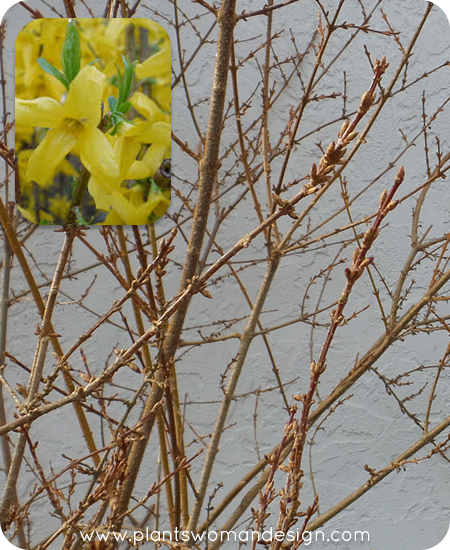
Forsythia X intermedia
This Forsythia was pre-existing on my property. I’m not sure of the variety but it is probably common Forsythia X intermedia, easy to grow and very yellow. I remember my mom bringing the twigs indoors and forcing the blooms in the dead of winter. It is a member a of the Oleaceae family and has light green leaves that appear after flowering. This is one plant like willow that will root in water if left after the blooms fade.
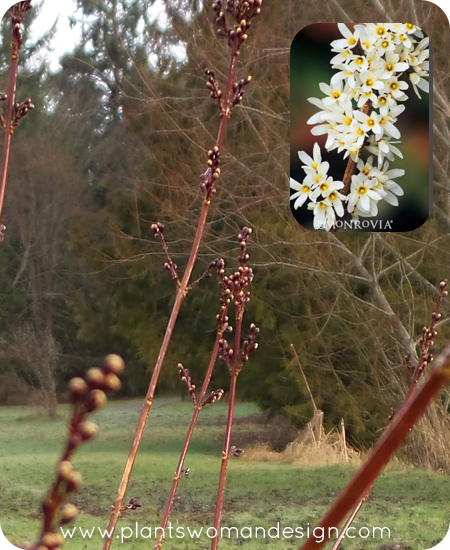
White forsythia (Abeliophyllum distichum)
This deciduous shrub is related to the forsythia, but differs in that it has white flowers that open in early spring before true forsythia. It is also a member of the olive family (Oleaceae). In early spring, before the new leaves form, purplish buds all along the grey naked branches open into small white four-petal, almond-scented flowers with yellow stamens. After flowering, green, glossy abelia-like leaves appear.
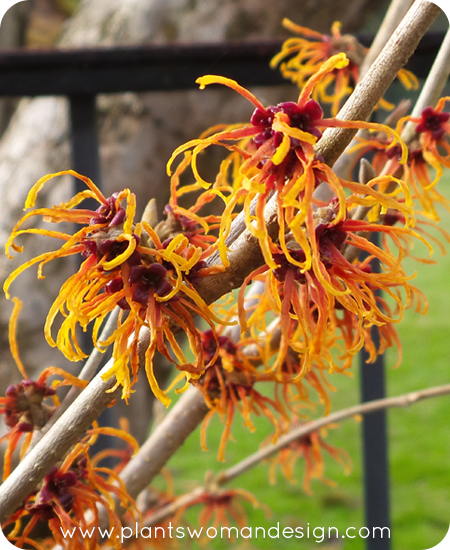
Hamamelis Jelena
Of course anyone that knows me knows I love orange. This is Hamamelis Jelena, a wonderful witchhazel that loves to bloom now with its coppery orange flowers lighting up the winter landscape. The bare branches have a sculptural quality that is a treat before flowering. The leaves come out after flowering and are wonderful ovals with deep ribs. The fall color is simply amazing too. It is hard to beat this plant for year round interest. It is one of those amazing ‘earn its place in the garden’ plants.
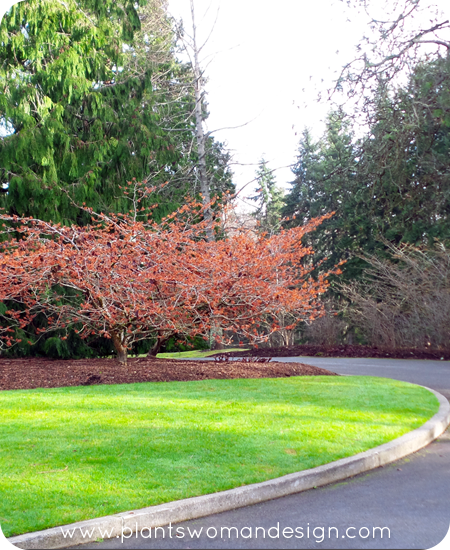
Hamamelis Diana
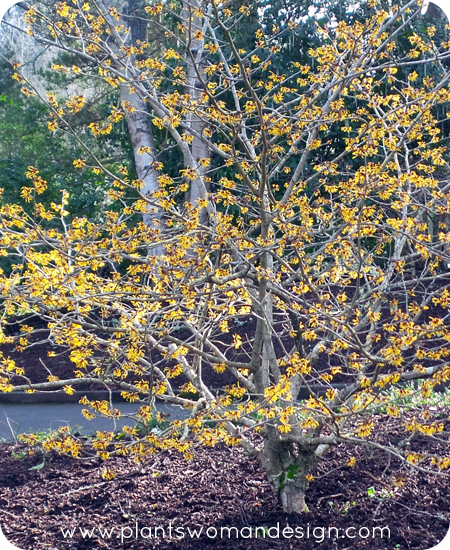
 possibly Arnolds Promise
possibly Arnolds Promise
I live close to the Bloedel Reserve which is a fabulous garden on Bainbridge Island. These two pictures are from the front entry. The striking Hamamelis in both the Orange (Hamamelis Diana) and Yellow (possibly Arnolds Promise) colors make a beautiful entry point. Remember from a design point of view these do earn their space in the garden. There are several varieties available including yellow, orange and red flowers, some are intensely fragrant. I did stumble across a Hamamelis x intermedia ‘Feuerzauber’ (Fire Charm) at Valley Nursery today. It somehow found a place in my car and will soon find a place in my new garden.
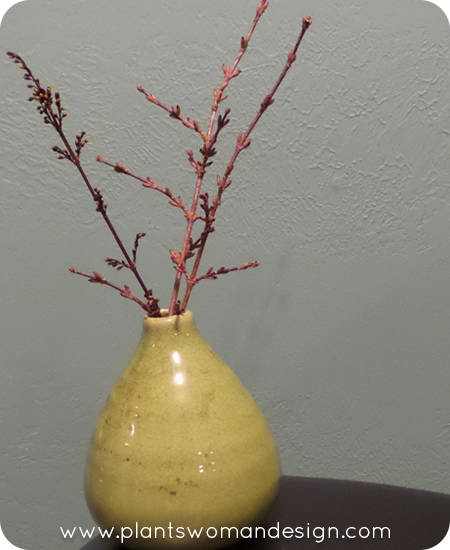 And last but not least here is a picture of the forsythia and abelliophylum in the process of forcing on my desk. I recently picked up some purple tulips and will pull some more forsythia from the garden to force together. The yellow and purple will make a stunning combination.
And last but not least here is a picture of the forsythia and abelliophylum in the process of forcing on my desk. I recently picked up some purple tulips and will pull some more forsythia from the garden to force together. The yellow and purple will make a stunning combination.
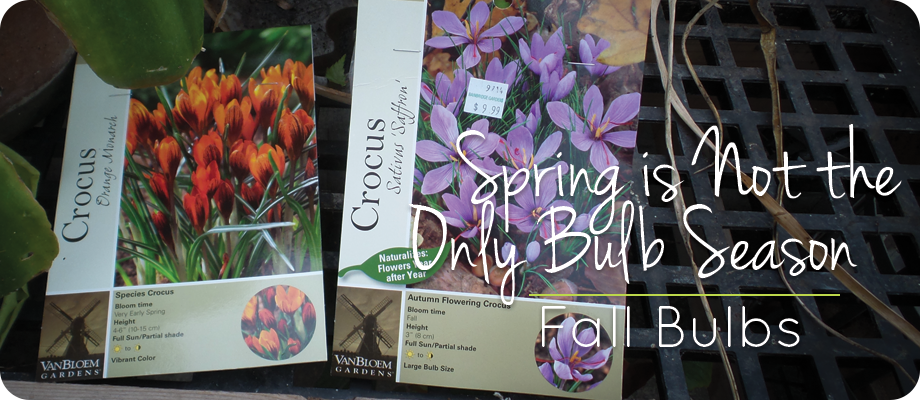
by Susan | Nov 5, 2014 | gardening
Some gardeners are unaware of the other season for some bulbs. Yes, there are summer blooming bulbs, like lilies and gladiolus, but the fall is another great time for bulbs. Fall favorites include Colchicum, saffron crocus and the Nerine.

image from www.pacifichorticulture.org
The Colchicum, which is an old fashioned bulb, is usually found in old homesteads. It is a fall blooming crocus that has large bright lilac blooms. The leaves come out in the spring and create energy for the bulb underground. In the fall the leaves die down and the blooms come out. Very cool and light under a tree.

image from www.sunset.com
Another fall blooming crocus is the saffron crocus, crocus sativus. This is a beautiful more traditional crocus in size but has the added benefit of saffron threads. If you have ever cooked with saffron you know how expensive it is. Here is a really good way to grow your own! Luminous purple with red orange long stigma (saffron) and yellow pistils, they are stunning! These are available at nurseries and on-line (I can’t say it enough, buy local!). They can be planted now and you should see results in the late fall (in my Zone 7 garden).

One of the holy grails of bulbs and little known in cultivation in the Pacific Northwest is the Nerine. This is a beautiful mystic flower. I found one in the cut flower section of my local florist this month and was again reminded of their loveliness. They are mostly from South Africa and are not hardy here. The Nerine Bowdenii is hardy in our area. More cultivars using the Nerine Bowdenii have been developed and new color changes have been created. Many gardeners grow nerines in their greenhouse. The Pacific Bulb Society has good information on growing and displaying nerines. They put me in touch with a website that have nerines for sale at a reasonable price. Nerine undulata is on its way to me even as we speak. It is not hardy here but I should be able to keep it in my greenhouse. This nerine blooms in the summer and is beautiful and spider like.
Here are a few Nerines on order from www.telosrarebulbs.com.

image from www.telosrarebulbs.com
6450 Nerine masoniorum Zone 7-10

image from www.telosrarebulbs.com
6460 Nerine sarniensis var. corusca major zone 8 – 10

image from www.telosrarebulbs.com
6471 Nerine hybrid ‘Venus’
The Nerine hybrid ‘venus’ has nerine bowdenii as a parent so it is hardy to zone 7.
In case you were wondering how to plant these lovely bulbs take a look at the video below.
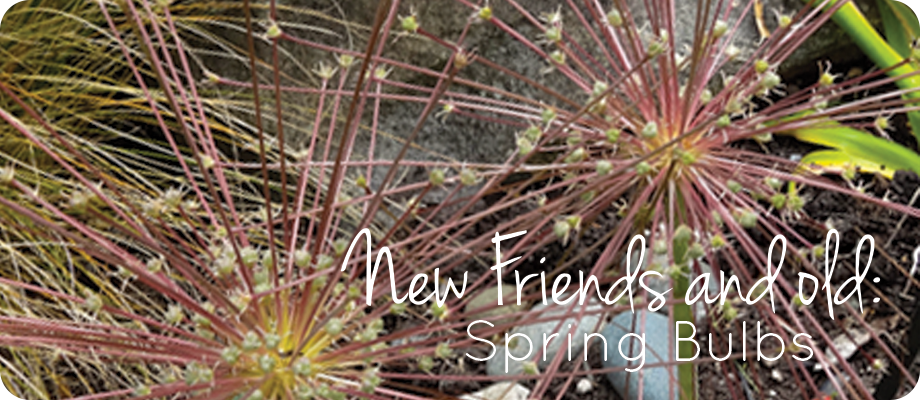
by Susan | Nov 1, 2014 | gardening, Plantswoman Design
Knowing what you like is a good thing. Trying something new is a good thing. Heading into the fall and thinking about spring bulbs I have to think about both things. One of my most favorite bulbs is Allium Shubertii.
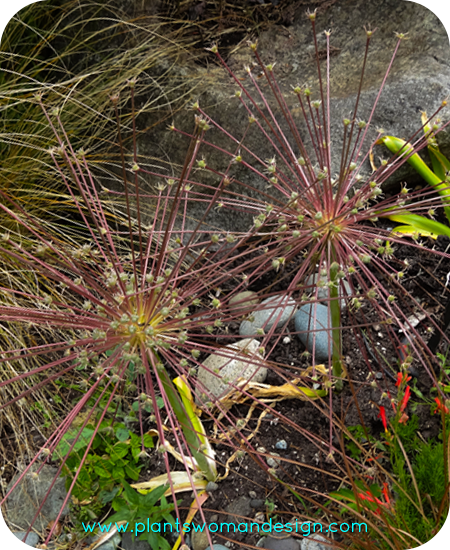
Growing at the top of the path to the bottom garden in my old garden it never failed to amaze. In the late spring the leaves would show up and then the blooms fast behind. As the season ramps up the blooms loose their purple and become a wonderful honey color. I always pick them and bring them indoors. The uses indoors are unlimited. I use them as sculpture, spray them with white paint and glitter, (watch for them in gather post coming up), and stack them in old wooden troughs with other drying foliage. A must have for my new garden. Beware where you plant them. A customer in the city complained that passerby’s stole the bloom and even the bulbs from the planting by the sidewalk. Addictive is a word to describe this bulb!
Another must have is a species tulip batalini. There are two cultivars available one is bright gem and the other is bronze charm.

image from Pacific Bulb Society

image from tulipbulbs.com
This sweet little tulip is perfect for the edge of a path. I like it up on an edge of a rock wall that you walk past. I planted 6 several years ago and they multiplied to about 25. They like quick drainage, are drought tolerant and surprisingly deer resistant. For some reason this usual deer candy (tulips) is not a favorite. I love not worrying about them at all. Slugs don’t care about them and as you are walking by them they seem to pop up out of nowhere to cheer and surprise you.
This year on my new list is a couple of items from the tulip blog this past spring. www.Tulips.com is the website for the Skagit Valley tulip festival bulb producer, Roozengaarde, that sells the bulbs you see in the fields. My tries this year will be a parrot tulip called Irene, orange with reddish purple flames.
Another Species Tulip called clusiana Carmine, red with white edge (looks like the same cultivation as the Batalini tulip). They should be really great.
Clusiana at www.tulips.com
Sometimes there are special cultivars that are developed and tested one of which is the Ice Cream Tulip. I’m not sure that it will be a hit or not. It is dark pink on the outside of the tulip and has a raised section in the middle that looks like ice cream in a dish. Check it out and tell me what you think.
Ice Cream Tulip at www.tulips.com
At the Northwest Flower and Garden Show Last year one of the other gardens had a beautiful white tulip that was forced from the gardens in the Skagit Valley. Tulip ‘The Edge’ was amazing. It has great foliage with a small white edge of color on the leaves and pure white bloom.
The Edge at www.tulips.com
I ordered them last week and they were delivered today with instructions to plant immediately. I waited to order because it has been warm here. Sometimes if you put spring bulbs in the ground too soon they will start to sprout. We get some good cold weather but this year it hasn’t been cold yet. Gardeners in warmer climates will have to chill in a refrigerator and plant about 12 weeks before you want them to bloom. Good instructions for planting in warm climates is available on the website.
Valley Nursery had a new tulip on the shelves when I went to get bamboo for a customer. (always a danger). Tulip ‘Clouds of Cotton’ looks to be really beautiful. They have a new home in one of my new planting beds. I’ll be looking forward to seeing the blooms and reporting on how they do.

image from www.pikenursery.com
Here is a note to other on-line shoppers. I have ordered from other on-line bulb places in the past. I have not had good luck from the so-called discount bulb sellers. Last year the bulbs I ordered for the garden show had a less than 50% germination rate. Other garden creators had ordered from a local source and they had great success. I would have to say BUY LOCAL!
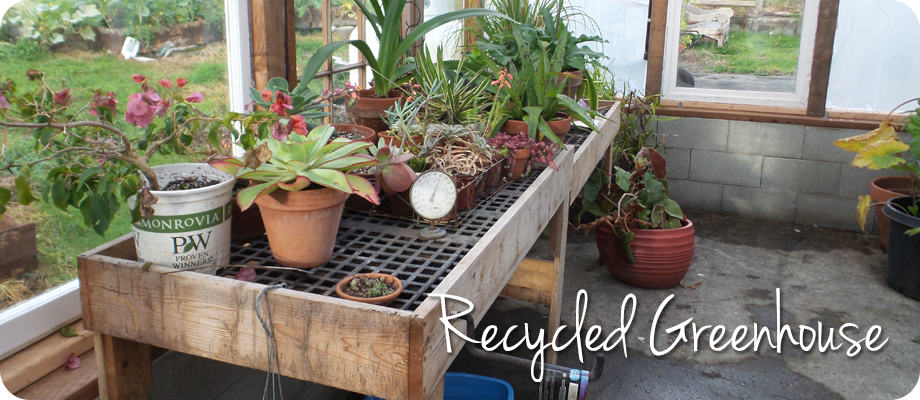
by Susan | Oct 24, 2014 | gardening
When I left my other house I left a little greenhouse. It was only about 10X 15 and under a deck. It didn’t have much light and I used a heater to keep it warm with florescent grow lights.
I need a place for my non-native and non-hardy plant obsession which my place didn’t come with. I have several New Zealand plants, a red banana, orchids and clivas that will certainly need a home sooner rather than later.
Why not design a greenhouse? I though I could give it a whirl so I started out with a base of concrete block. It was set out and partially filled with concrete mix for stability.

Then off I went to a couple of places that reclaim building materials to look for some old windows. Ballard Recycle and Reuse had some great windows and a good storm door. The windows were $5.00 a pane and the lovely green door with brass knobs and kickplate for $45! Restore, a Habitat for Humanity store, is another place that has some great windows. I don’t have enough windows to do the entire greenhouse yet so we installed them on the bottom section. I used 9-mil plastic to cover the rest of the greenhouse. When I get some more windows I will replace the plastic as I go.
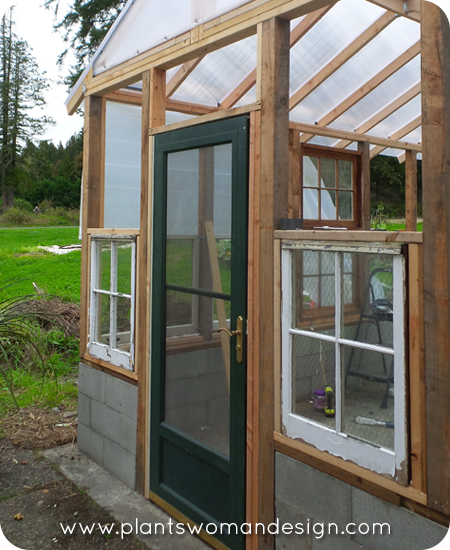

I did spend a little money on the roof. Sunlite panels and rafters gave some room for the banana, the old greenhouse always struggled to contain the leaves. They would keep growing even with the little bit of winter light.

I had some tables from the old greenhouse that I reused in the new one. A couple of lights and a fan will also hang from the rafter with a new heater in the back. There is circulation from a window beneath the heater and the door with and screen door panel.
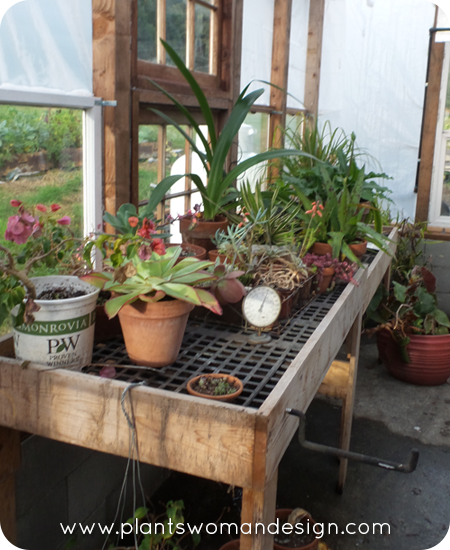

Eventually I will be able to put some rock on the sides of the greenhouse with mortar. I will have time to make it pretty later for now it is functional.


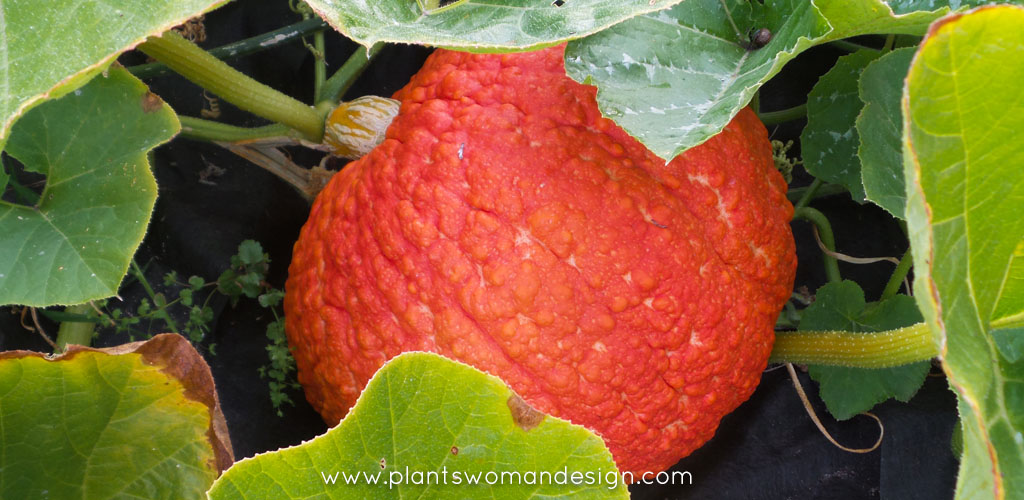
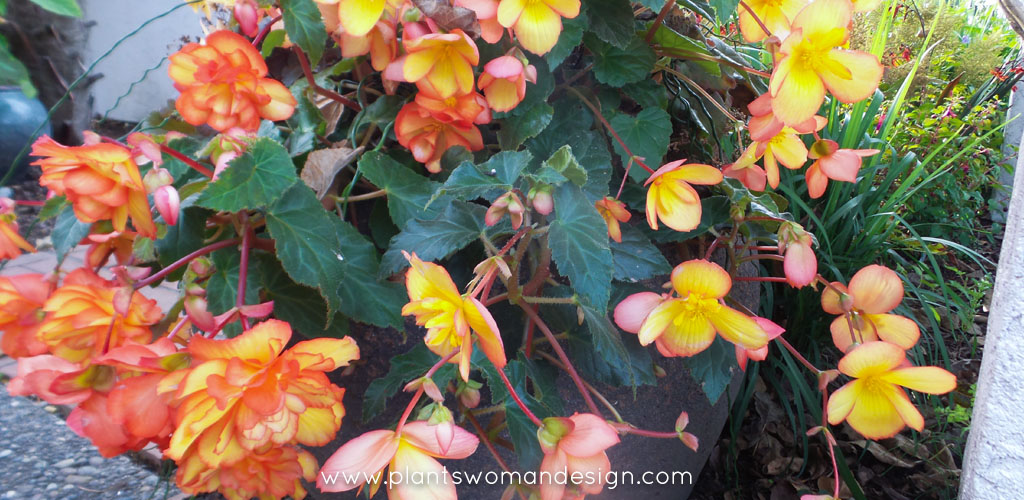
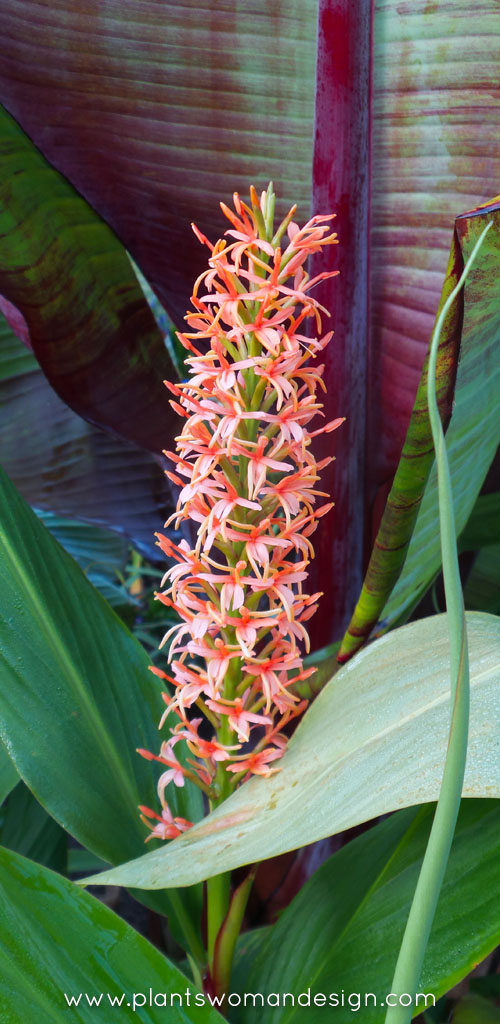

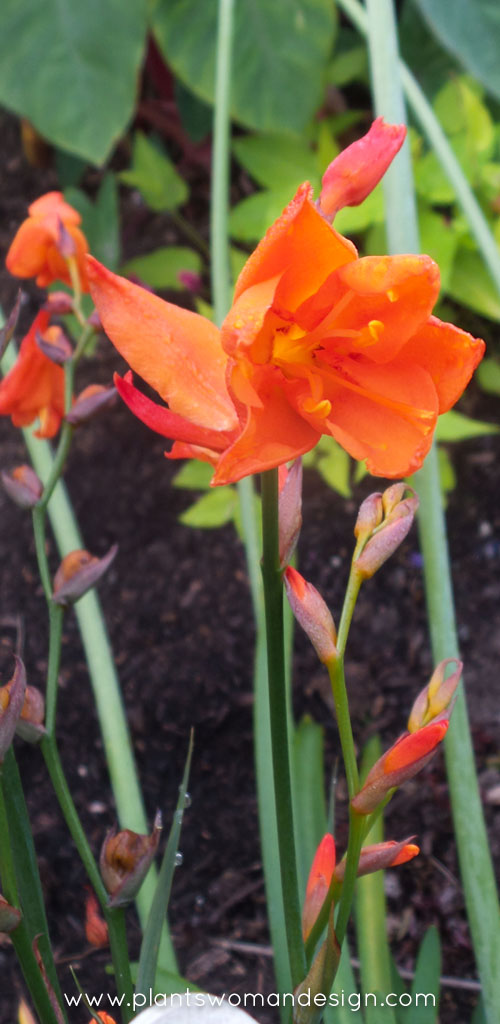
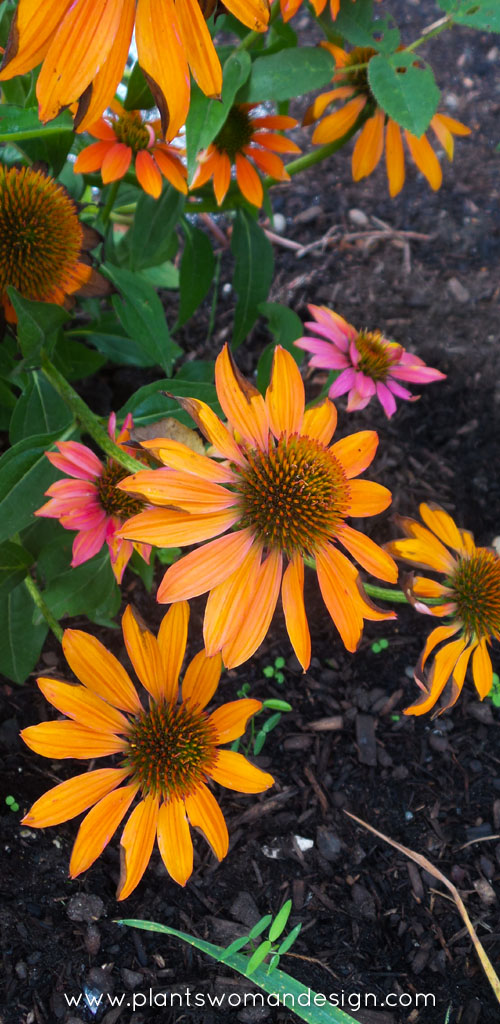
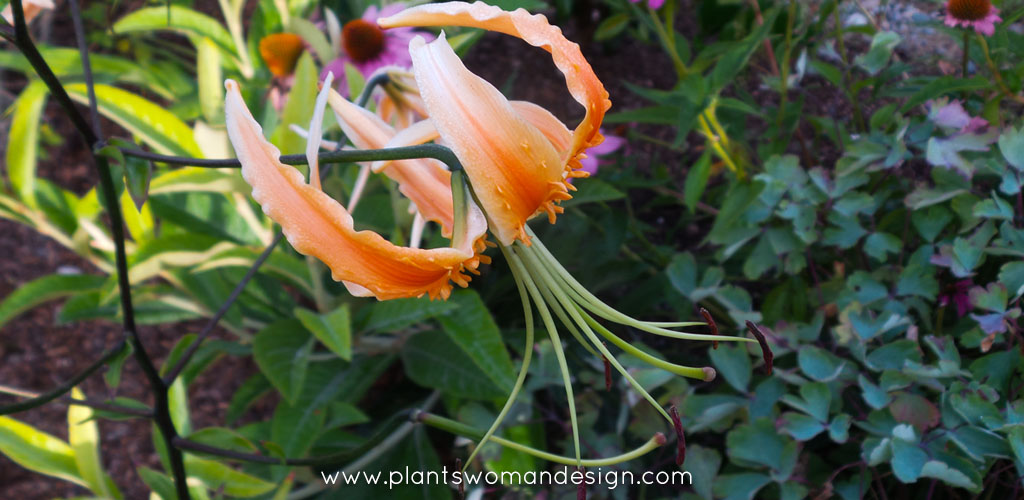
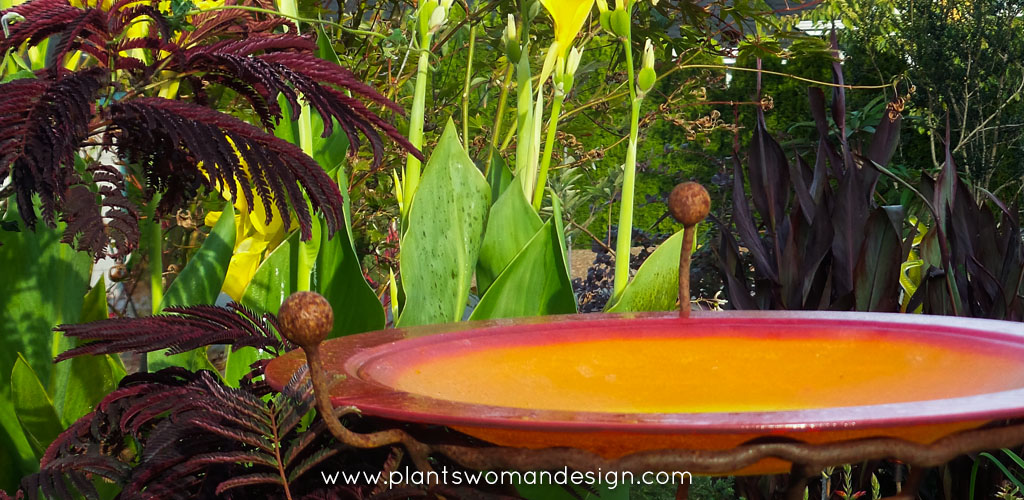
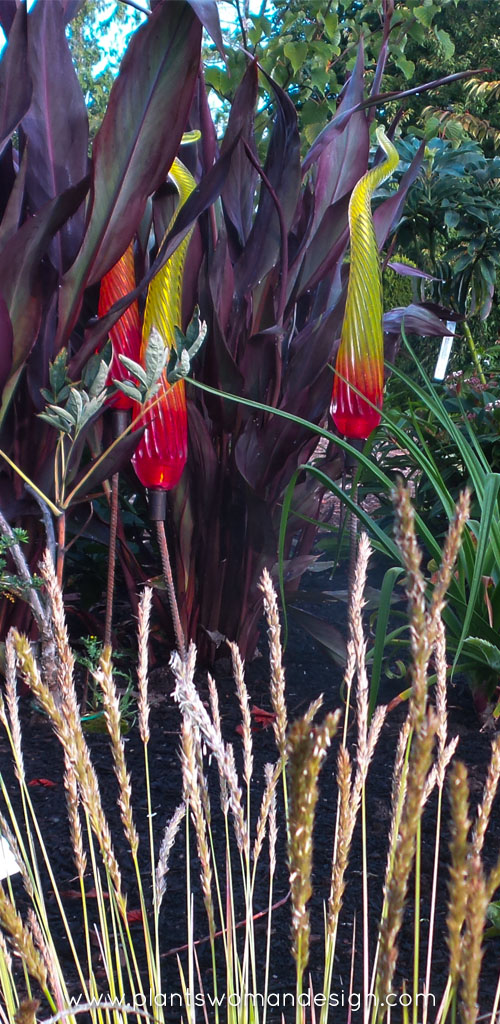
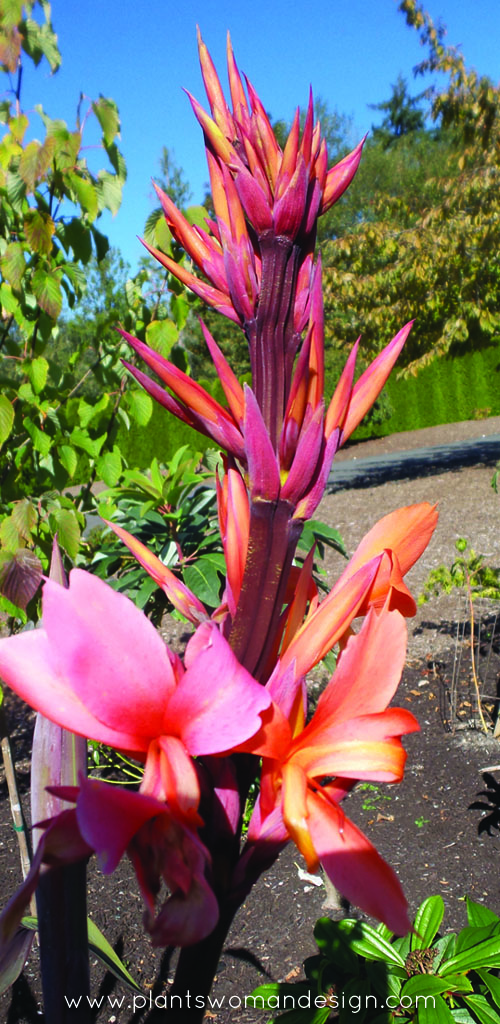
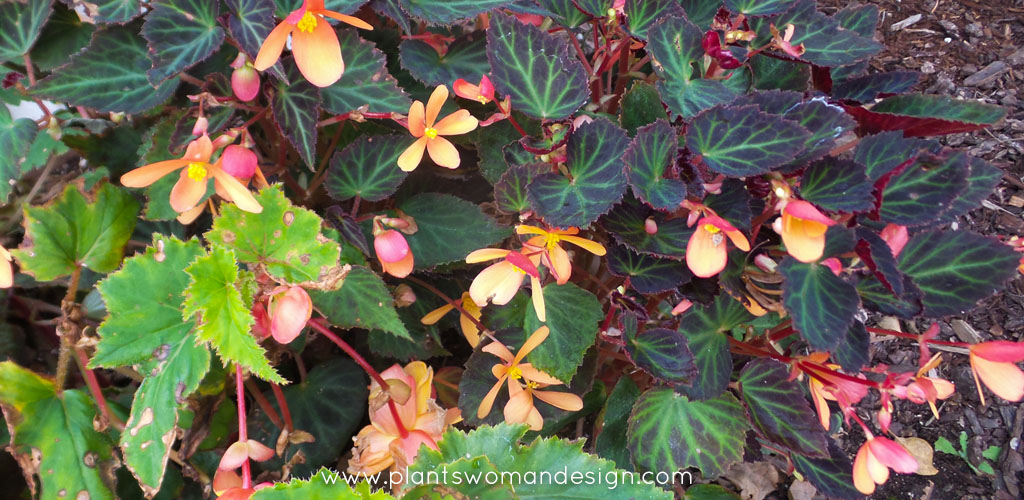
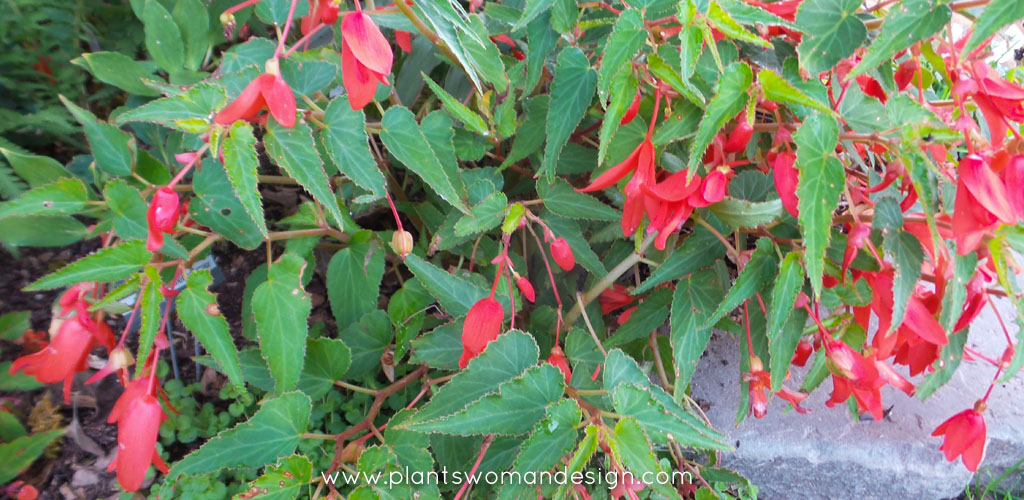


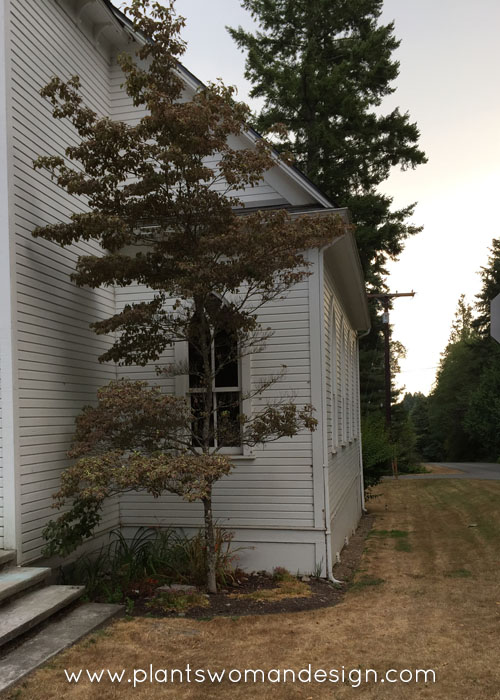
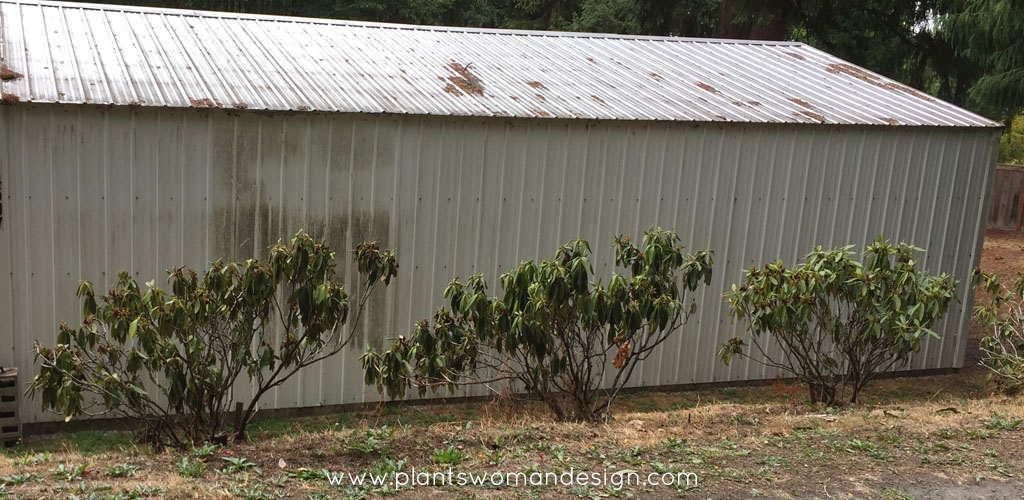
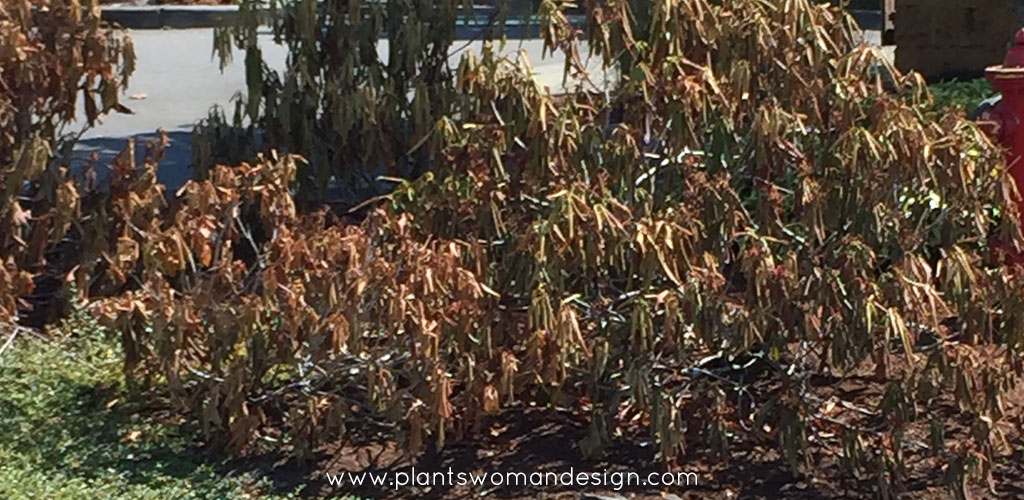


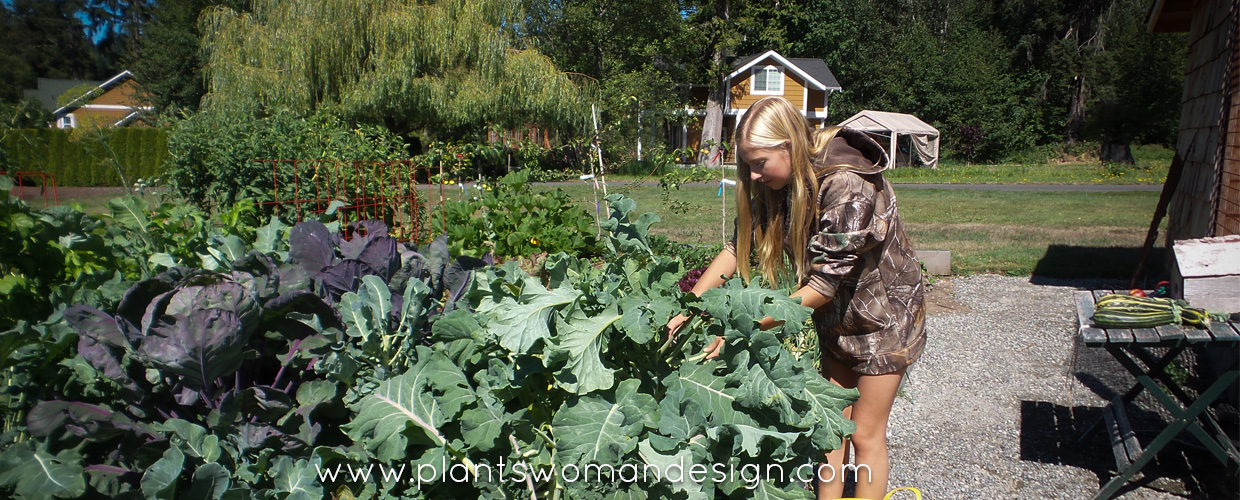


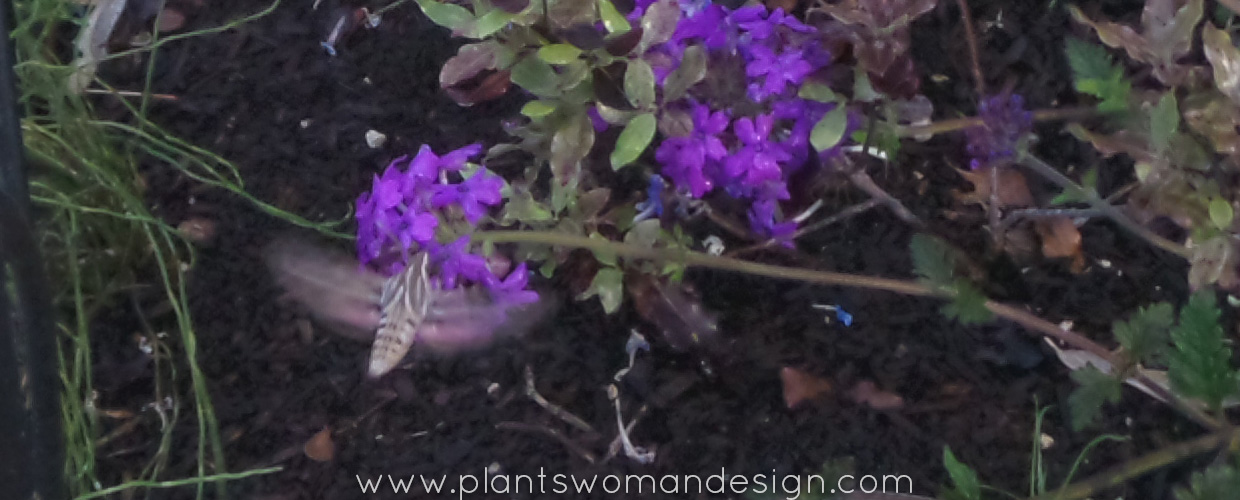












 possibly Arnolds Promise
possibly Arnolds Promise











